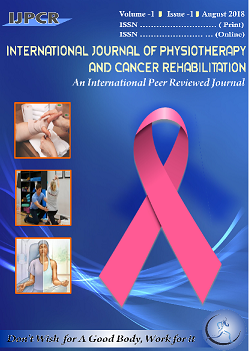International Journal of Physiotherapy and Cancer Rehabilitation
SEARCH
Our Founder
Popurlaly known as ‘jannu bhai’, the Late manishi’s vision, farsightedness and sacrifice have enabled us reach the stature we enjoy today More...Vice Chancellor's Message
It gives me immense pleasure to learn that the 1st volume of international journal of physiotherapy and cancer rehabilitation is being More...Cover Page Volume I Issue I
 .
.
IJPCR
EFFECT OF 4 WEEK ON TWO PASSIVE STRETCH MANEUVERS ON PECTORALIS MINOR LENGTH AND SCAPULAR KINEMATICS AMONG COLLEGATE SWIMMER
Arpit Kamboj Dr. Saleem Akhtar Naqvi Dr.Aashish Jain
Abstract:
Background & objective: Swimming is a sport enjoyed by all ages. Approximately 100 million Americans consider themselves swimmer, making swimming the most popular sport in the united states. Some of these people swim competitively, other swim for fitness, and other for reaction. Swimming can be done safely by people with musculoskeletal systems that cannot withstand the impact forces found in running, jogging or jumping. Swimming is also highly regarded as an aerobic activity. Competitive swimmers may cover 10,000 to 14,000 meters a day 6 to 7 days a week. Some distance swimmers may swim up to 24,000 meters a day. This equates to 16,000 shoulder revolutions per week. Swimming is an unusual sport in that the shoulders and upper extremities are used for locomotion, while at the same time requiring above average shoulder flexibility and range of motion (ROM) for maximal efficiency. This is often associated with an undesirable increase in joint laxity. Furthermore, it is performed in a fluid medium, which offers more resistance to movement than air. This combination of unnatural demands can lead to a spectrum of overuse injuries seen in the swimmer's shoulder, the most common of which is rotator cuff tendinitis and pectoralis minor tightness. Observation of the scapular posture is one of the most important component of the physical examination in overhead athletes.
Design of study: Experimental study.
Methods: A convenience sample of 30 swimmers subject divided into two group, Group A and Group B who fulfilled the inclusion criteria were included in the study. After the collection of demographic data, a detailed tightness of pectoralis minor was measured by inch tape method. The measurement were taken by standing the participant erect with resting his arm at their side. The distance was taken between origin and insertion of the muscle. The scapular protraction was measured in three position of the shoulder joint i.e 00, 450, and 900. The lateral part of caliper was placed on top of inferior angle and medial part of scapula was placed on corresponding spinous process. The scapular measurement for maximum abduction was measured with gravity inclinometer, the device was placed in the root of spine of scapula. This position was established so that when subjects elevate his arm, their arm were raised in the scapular plane (400 anterior to the frontal plane) while maintaining the contact with the guide pole. The measurement is taken in the maximum elevation of the arm.
Keywords: pectoralis minor tightness, scapular upward rotation and protraction